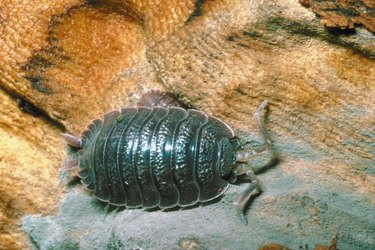Things You'll Need
Pesticide
Egg shells
Boards
Water
Ducks

Finding Doodle Bugs in your yard can be disconcerting, but that doesn't mean you can't get rid of them without too much cost or preparation. Also called the ant lion, roly-poly, sow bug and pill bug, these creatures are used regularly by biologists to teach children about Mother Nature's natural wonders.
Step 1
Diagnose your yard. Doodle Bugs prefer sheltered areas filled with soil that shifts easily so they can burrow into the ground to build pits for depositing eggs. You may also find Doodle Bugs in sunny, dry areas of your yard – particularly areas offering shelter from the elements. You could find a concentration around exterior air conditioning units, flowerbeds with and without mulch or under hedges and building eaves. Doodle Bugs are programmed to breed and when the moon is full, they dig egg depository pits even deeper into the soil than usual.
Video of the Day
Step 2
Correctly identify the bug so you don't use the wrong remedies when searching for products. Look for grey or brown bodies, armadillo-like skin, at least six legs and body lengths between 1 and 2 inches. You may have to overcome your squeamishness to finish identifying Doodle Bugs: Pick one up and If it rolls up into a tight ball, you've got your bug, though if you caught them dining on tender treats growing close to the ground -- like young veggies and flowers – that's also a big clue.
Step 3
Decide whether you want to use a chemical or natural biological method to rid your yard of a Doodle Bug infestation. If you don't mind pesticides, the main ingredient of a chemical-based Doodle Bug application is called "Sevin," so ask your nursery owner, university agricultural extension agent or garden store employee for a pesticide containing this ingredient. Follow package instructions to lay down the bait or you can mix it in mashed bananas. The Doodle Bugs will dine on the dish and expire.
Step 4
Try a non-chemical intervention if you have young children, pets and/or people spend lots of time in your yard. Take out your Doodle Bug population by creating a dark environment in infested areas of the yard: Place cardboard or sheets of material on the ground. You'll trick them into thinking it's night and when you whip off the cover and find them congregating, pour boiling water over the creatures and they'll literally curl up and die. If you find that method too cruel, try scattering crushed eggshells over the infested areas to see if that solves your problem.
Step 5
Bring in the ducks. Even one duck can grow big, fat and healthy on a diet of Doodle Bugs and with those beaks, insects can run but they cannot hide. Females lay around 20 eggs per site, so once they move in, you're limited to the aforementioned treatments if you decide not to hire a gaggle of geese or a couple of ducks to do the job on your behalf. Of course, you can make friends with the Doodle Bugs if you don't mind sacrificing some of the newest plants in your yard. This insect species does an outstanding job of ridding yards of bugs that you probably like less than Doodle Bugs, so if you're plagued with other insect infestations, you may wish to call a truce.
Video of the Day
- Texas Agricultural and Mineral University; Aggie Horticulture; Insect Pests; Question 16
- University of Florida; IFAS Extension; Watch Doodlebugs for Summer Fun; Dan Culbert, Extension Horticulture Agent; June 2005
- New York Times; A Gardener’s World; If Aardvarks Ruin the Plants, Don't Get Tabasco on the Elves (2); Allen Lacy; June 1992